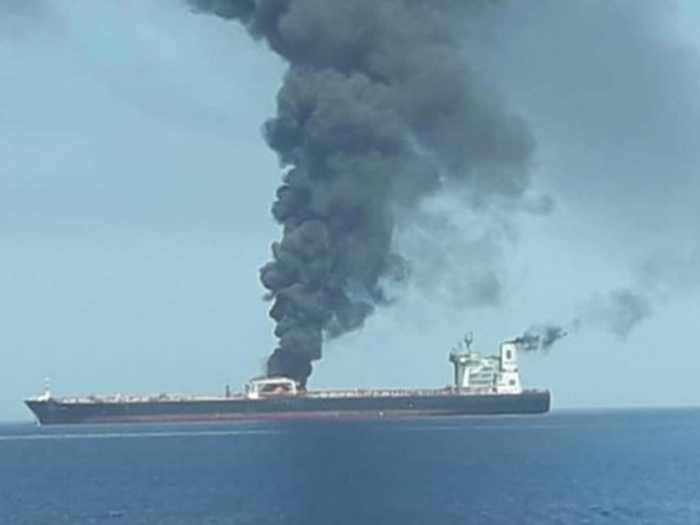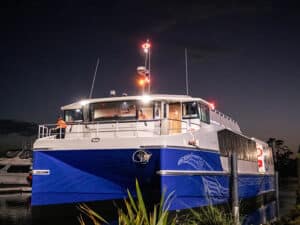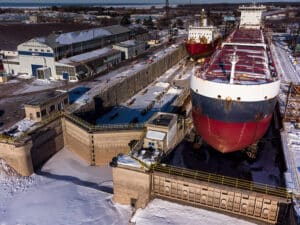
Two tankers attacked in Strait of Hormuz
Written by Nick Blenkey
Image: Iranian state controlled media
Attacks on two tankers in the Strait of Hormuz made headlines this morning. Iranian state controlled media showed images of a pillar of smoke rising from one ship and reported that Iranian vessels had rescued the crew of one vessel.
The two ships involved are the Frontline tanker Front Altair and the chemical taker Kokuka Courageous. Front Altair is managed by Wilhelmsen subsidiary International Tanker Management. Kokuka Courageous is managed by Bernard Schulte Shipmanagement.
DRYAD ANALYSIS
Amid a welter of sometimes conflicting reports, London based maritime security specialist Dryad Global today released this initial analysis.
“Reports indicate that two vessels transiting the Strait of Hormuz in South Easterly course were attacked, in an incident which is still being investigated. The two vessels involved have been identified as the crude oil tanker Front Altair and the chemical tanker Kokuka Courageous. Front Altair is Marshall Islands flagged, and Kokuka Courageous Panama-flagged. The Front Altair is believed to be carrying 75,000 tons of Naptha originating from Abu Dhabi’s ANDOC. The Kokuka Courageous is believed to be carrying methanol, originating from Saudi’s Sabic and also Qatar. Front Altair’s speed is reported to have dropped from 12 kts at 0205 UTC, to 2.7 kts at 0321 local time, indicating the time of incident. Reporting indicates that a distress signal was reportedly sent by the vessel Hyundai Dubai at 0612UTC on behalf of the Front Altair. Kokuka Courageous’ speed is reported to have dropped from 14 kts at 0133 UTC, to 0.2 kts at 0620 UTC with a distress signal being received at 0700 UTC. Front Altair’s position when it lost speed significantly was at N 25° 26’ 27.13, E 057° 23’ 18.42, at 0248 UTC.
“Front Altair was believed to be fully laden when the attack took place, resulting in a large fire and the crew being forced to abandon ship. Reports indicate that the cargoship Hyundai Dubai aided in the rescue effort.
“Reporting suggests that 21 members of crew have been evacuated from Kokuka Courageous, and the crew are believed to have reported that its cargo of methanol is intact. Additional but unconfirmed reports have been received by Dryad sources indicating that IRGC vessels were the first vessels on scene to offer assistance. It is believed that this assistance was refused by the crew of the Front Altair, however unconfirmed reporting indicates that the crew of the Kokuka Couragous may have been taken to the Iranian Port of Bandar-e-Jask.
“Both vessels appear to have indicated that they believe the attack originated from the surface, however further reports from the Front Altair indicate that the hull was breached on the starboard side partially below the waterline.
“The incident was initially primarily reported by the U.K. Maritime Trade Operations (UKMTO) and the U.S. 5th Fleet, which is believed to be in attendance at the scene.
“Front Altair’s current position as reported by AIS is N 25° 22’ 59.21, E 057° 23’ 53.65, at 0945 UTC. Kokuka Courageous’ current position is reported to be 50 km East of Front Altair.
“Iranian media reports have claimed that Front Altair has sunk, however Frontline which operates the vessels has denied that this is the case at 0957 UTC.”
CONTEXT
Dryad notes that this latest incident has occurred one month and a day from the previous incidents where four vessels were targeted within the Fujairah anchorage. The latest incident has caused a steep price rise in oil, and Brent Crude has risen 3.85%, standing at $62.28 as at 1153 UTC.
ASSESSMENT
“Incidents of this nature in relative close proximity are extremely worrying, and are indicative of rising tensions in the region,” says Dryad. “On a broader regional scale, the attack will serve to deepen tensions between Iran and the U.S., which have gradually escalated throughout 2019.
“It is a realistic possibility that Iran or a proxy were behind this attack, however the situation remains fluid and there are a number of competing narratives that require examining. It is important to note that the attack on the Front Altair is reported to have struck the starboard side of the vessel, which was traveling in a southerly direction. Any Iranian involvement either directly or via a proxy is unlikely to have conducted an attack from the port side, as this would immediately give rise to allegations of Iranian shore launch projectiles which would require Iran to refute blast diagnostic evidence from the outset. Thus far the methodology of a starboard side attack is consistent with what would be expected of Iranian involvement. The reported involvement of Iranian vessels in the rescue effort may also be an attempt to obscure intent in the aftermath of the attack, however this cannot be confirmed.
“However, any assessment of Iranian involvement must be contextualized, and must be analyzed through the prism of self-interest and motive. States such as Iran are rational actors, and will not conduct attacks in the Strait of Hormuz merely to ‘disrupt’ global shipping, without there being a clear national interest in doing so. At a time where the Iranian economy is struggling and sanctions are biting, it seems surprising that Iran would endeavor to conduct such a bellicose strategy. It would also be remarkable that Iran would knowingly target vessels reported to be carrying ‘Japan-related cargo’ at the same time that the Japanese Prime Minister Abe is conducting talks in Iran. These inconsistencies in terms of interest and motive do not rule out Iranian involvement, but they do suggest that a wider regional narrative may be at play, and that the responsible party could in fact not be Iranian once a further investigation is completed. It is important to note that despite recent events pointing to Iranian involvement, no key lines of evidence indicating responsibility or intent have been identified. While the security threat which the incident poses can be quantified and responded to, the underlying details are still emerging, and will continue to be assessed by Dryad.
“In the short term, the threat to vessels in the Strait of Hormuz has undoubtedly risen, however this is still a localized event, and is likely not to be part of a pattern of events which will develop in the next 72 hours. Dryad deems that the threat from this event does not span into the wider Gulf of Oman, and vessels transiting through the Gulf are deemed to be safe. Vessels are advised to follow BMP5 best practice, and request routinely updated security briefings, when transiting the Strait of Hormuz”




